Cyclocross: Everything You Need to Know about Cyclocross Training and Racing
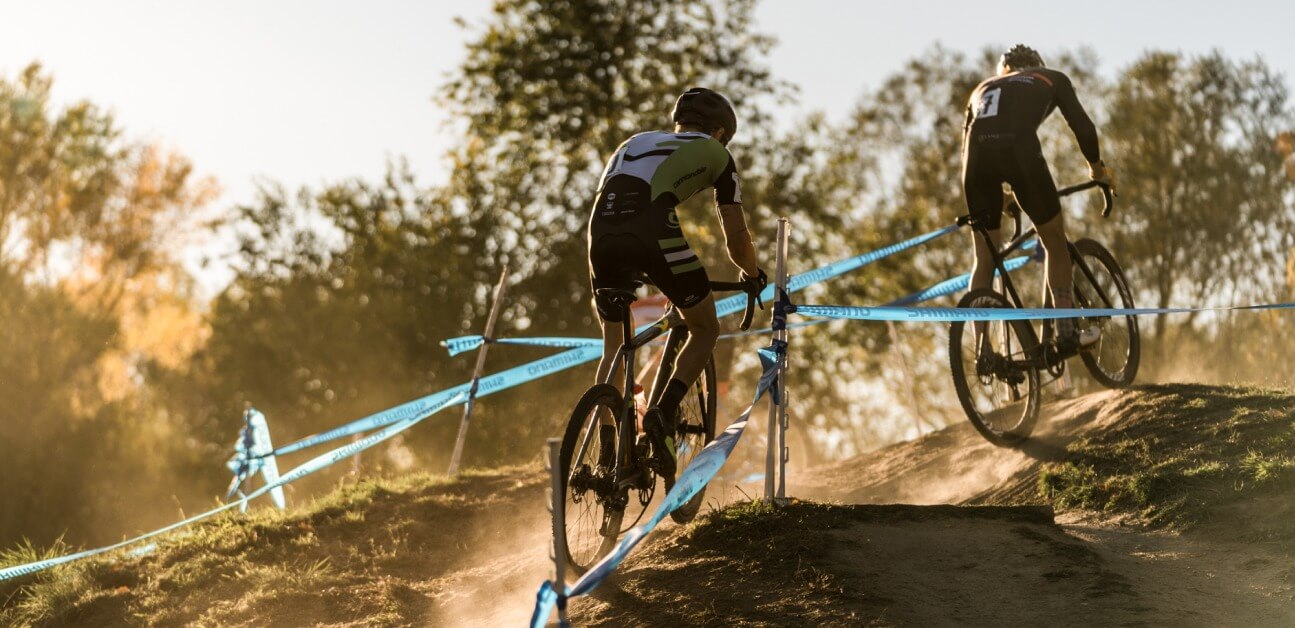
Cyclocross is an exciting and intense form of racing with passionate fans and competitors. But what is ‘cross and what is the best training plan for it? Whether you have the technical skills and fitness of both a mountain biker and a roadie, or you’re on a path leading you to this incredibly entertaining cycling discipline, this guide will cover everything you need to know about cyclocross training.
Special thanks to TrainerRoad’s Ivy Audrain for assistance in developing this blog post.
What is Cyclocross?
Cyclocross is a unique form of racing that combines some aspects of road racing and mountain biking. The races take place over a short course that typically includes stretches of grass, sand, and pavement, with obstacles dispersed in between. Races can last anywhere from thirty minutes to one hour as cyclists repeat the same loop, frequently having to hop off their bikes and run over obstacles.
Most cyclocross races take place in the fall and early winter as the sport was originally viewed as a way to keep fit during the offseason. However, with the rising popularity of cyclocross events, many cyclists make ‘cross a priority and train exclusively for it.
Fitness Demands for Cyclocross
Cyclocross is more than a test of who has the highest FTP or the ability to ride at threshold the longest. Courses are specifically designed to slow you down, whether it’s barriers, sand, run-ups, or tight turns. These speed checks result in repeated accelerations. Not only does this place a heightened emphasis on technical skills, but also requires a deep aerobic capacity to recover from these accelerations while continuing to ride at a high percentage of FTP.
Adaptive Training
Get the right workout, every time with training that adapts to you.
Check Out TrainerRoadThat said, anyone can develop the fitness and skills needed for cyclocross. With the right training plan, you can develop your ability to repeat hard efforts in a relatively short time.
Cyclocross Training Plan
A cyclocross training plan prepares you for the varied nature of cyclocross racing by targeting high-end sustainable power, the ability to generate high force at low cadences, and the development of repeated, high-power outputs following little if any recovery. The most efficient way to build these is through a blend of Threshold, Vo2 Max, and Anaerobic interval workouts.
Every TrainerRoad training plan includes a full Base, Build, and Speciality Phase. These progressive training phases are the best way to develop the specific fitness needed for your goal event. It does this by stressing the right energy systems to drive adaptations at the correct times in your season. Progressive training begins by building general base fitness, then layering on more specific work, eventually bringing your overall fitness to a well-timed peak. The TrainerRoad Cyclocross plan includes Sweet Spot Base, Short Power Build, and the Cyclocross Speciality phase.
When to start cyclocross training?
When you want to start cyclocross training will depend on its priority in your season. For some, ’cross is always coming, and the season is a top priority. These athletes will want to devote an entire training cycle to the season, with a full 28 weeks of Base, Build, and Specialty training. As a result, some cyclists begin cyclocross training in the late spring or early summer.
For others, cyclocross is a lower priority after a full spring and summer of road or mountain bike racing. In this case, carrying the fitness from previous training and touching on the specific needed fitness will be more than adequate for racing, allowing for another fitness peak.
Depending on what your race priorities are, you have several options. You could plan your entire training around cyclocross and complete a traditional Base, Build, and Speciality Phase leading up to your most important cyclocross event. If this is the case, Plan Builder will create the perfect plan by accounting for your experience, schedule, and events. Let’s take a look at a few examples of sample cyclocross training plans from Plan Builder.
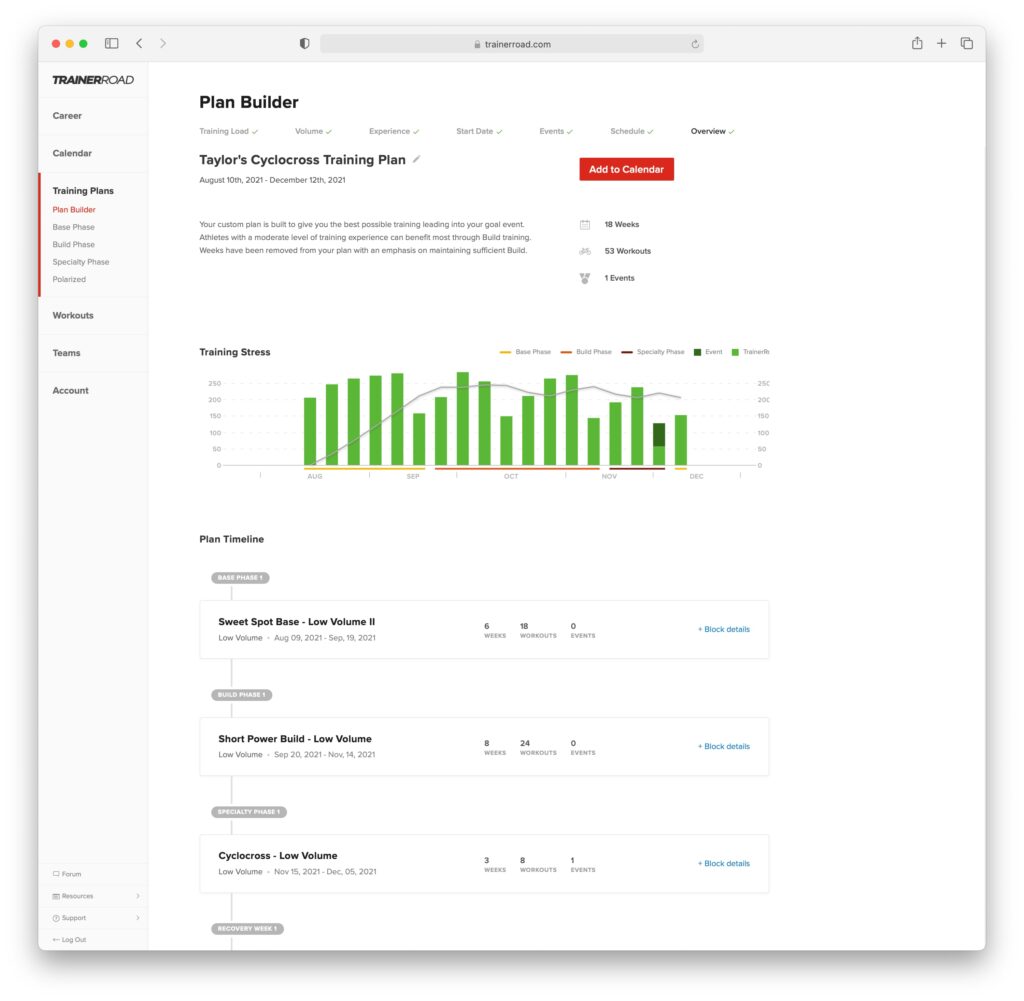
In this example, Taylor has gained a moderate level of experience training last winter and early spring. Over the summer they continued to ride, but with little structure. With 17 weeks until the cyclocross series championship, Taylor would benefit from touching up their aerobic base and completing a full eight weeks of Cyclocross Build, before heading into a shortened Cyclocross Specialty phase.
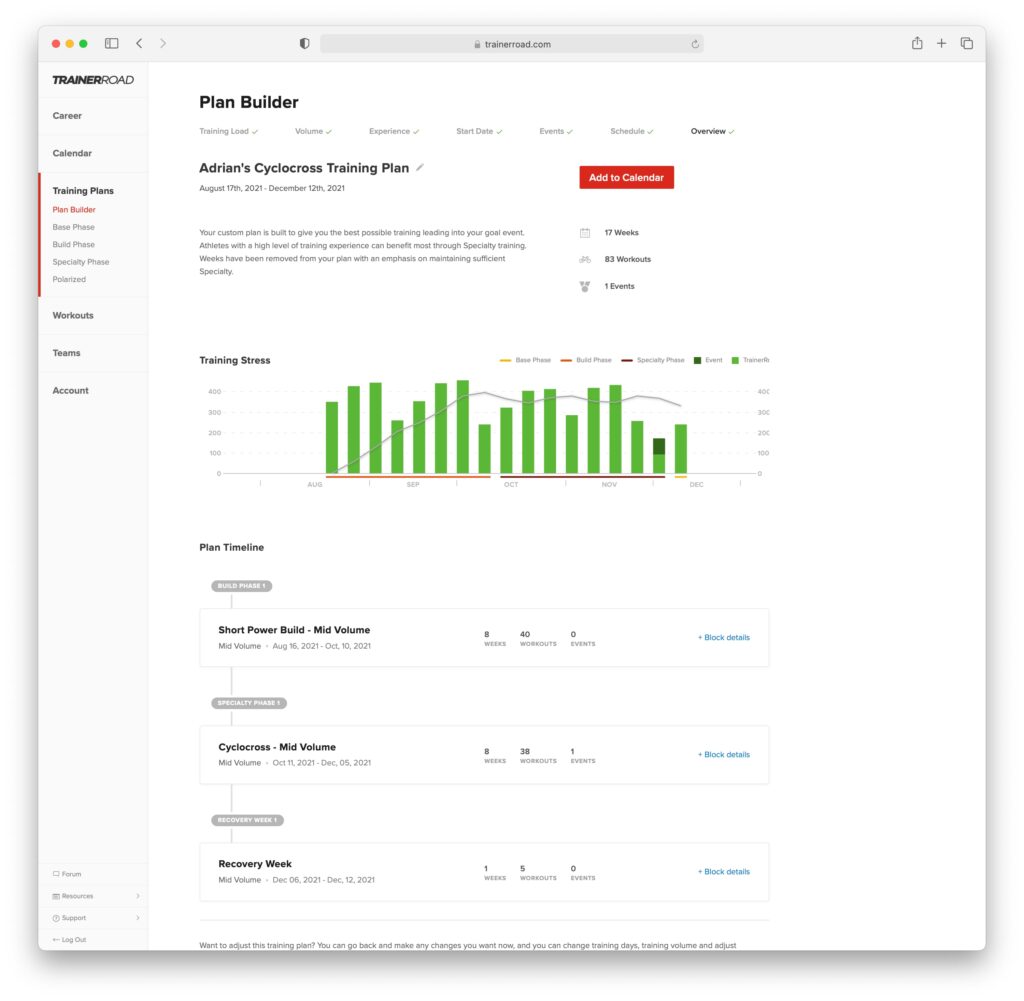
Here, Adrian is very experienced with structured training and is coming off a short break from early summer road racing. With 16 weeks until the cyclocross series championship, Adrian would benefit most from completing a full Cyclocross Build and Specialty, since they already have well-developed base fitness.

In this final cyclocross training plan example, the rider wants to complete a full Base, Build, Speciality progression leading into the season. Cyclocross base training will begin at the end of May.
How to Train and Race at the Same Time
Weaving lower priority races into your training plan is easy. You can either add races with Plan Builder or swap your scheduled workouts for your races. You can think of these as training races that offer excellent opportunities to get a hefty dose of race-specific stress as you near your goal event.
With the intensity of racing, you may need to make small adjustments to your cyclocross training plan following a race. If you’re carrying a little extra fatigue following your race and have a scheduled workout that looks too intense, feel free to take it down a notch by performing a lower-intensity, aerobic endurance workout like Pettit and postpone that harder workout a day or even two.
Cyclocross Workouts
Here are some examples of the workouts you can expect to find in a cyclocross training plan. If you’re not ready for a training plan or need some extra flexibility, you could even use TrainNow to select Attacking workouts that are intelligently recommended based on your current fitness.

The Brothers is an example of a VO2 Max workout with float sets. You’ll send fifteen seconds at 120% of FTP then recover while you “float” in the Sweet Spot zone. These types of workouts do an excellent job of simulating what a cyclocross race feels like and allow you to bolster your aerobic power.
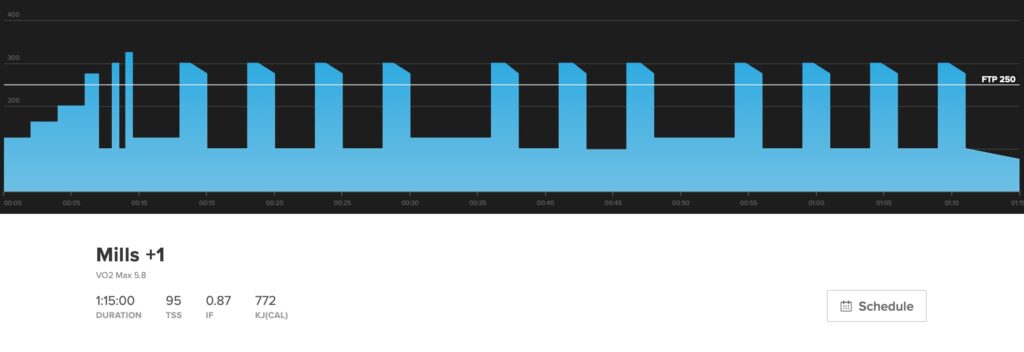
Mills +1 consists of three sets of two-minute V02 Max repeats. Working at high percentages of your peak aerobic uptake helps develop both aerobic and anaerobic power which is needed for the repeated accelerations and recovery in cyclocross.
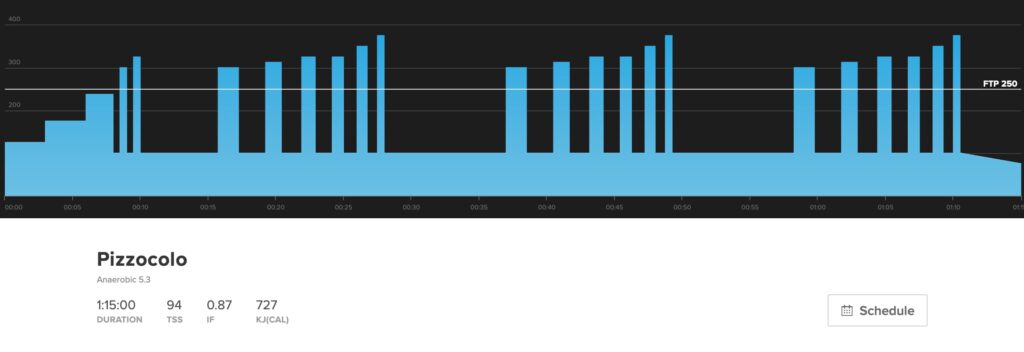
Pizzocolo is a workout focused on building your anaerobic capacity with intervals ranging from 120-150% of FTP. While difficult, these workouts are helpful for those repeated accelerations in cyclocross racing.

Middle Davis is an excellent cyclocross workout to build the muscular endurance needed to push more watts for longer durations—especially for when you need to accelerate, surge, or make a pass. These Sweet Spot intervals begin with a “hard start” at 150% of FTP before settling in ten minutes at 89%.
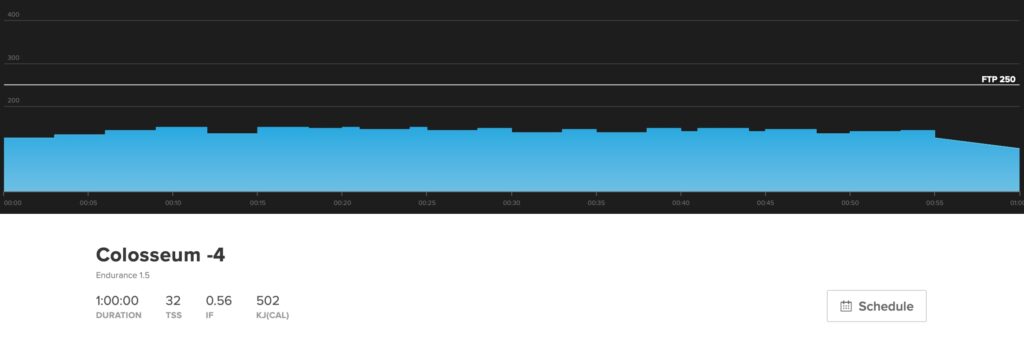
Not every workout has to be an intense one. If you’re racing an entire cyclocross series, less intense, endurance workouts can serve as one way to get in some work, without overloading your ability to recover.
Cyclocross Skills and Drills
Aside from the fitness demands, cyclocross is uniquely known for a wide variety of course obstacles. These can include barriers, sandpits, stairs, or run-ups, with most requiring you to dismount and run. For beginners, the most important skill to develop is a smooth dismount and remount.
If this skill is new, it can be helpful to practice the dismount and remount separately, then once you have the technique, put them together. Practicing dismounts can be a simple as finding an open field of grass (or another soft surface). Spending time on this crucial skill will help you get around the course faster. There are plenty of ways to dismount, below are some tips to help get you started.
Cyclocross Dismount Tips
- Make sure the pedal tension isn’t set too high. It may help to loosen it some, to help to clip out and back in.
- With enough speed to balance and your hands on the hoods, unclip your right foot and swing your leg around the back of the bike.
- Keep the frame close to your hip and place your right hand on the top tube.
- Unweight your left foot by leaning on your right arm, then unclip.
- Place your right foot on the ground first, then start striding with your left leg.
- Start slow. Once you have the technique down, you can gradually add more speed.
- For remounting, you want to think of it as a forward motion with your right leg guiding you back onto the saddle.
Equipment For Cyclocross
For many cyclocross series, race rules allow for a wide variety of bikes. So if you don’t have a dedicated ‘cross bike, don’t worry because you’re likely to see some gravel and mountain bikes at a local race.
However, there are plenty of benefits to riding a dedicated cyclocross bike for racing. When compared to a road bike, cyclocross-specific frames typically feature a shorter reach, steeper seat tube angle, and longer chainstays—all of which influence the handling and stability of the bike. Cross bikes also have increased clearance for wider tires.
Whatever bike you choose, it’s a great idea to run tubeless tires. While tubular tires have traditionally been a mainstay of cyclocross equipment, tubeless tires offer many of the same benefits of running lower tire pressures for increased traction.
